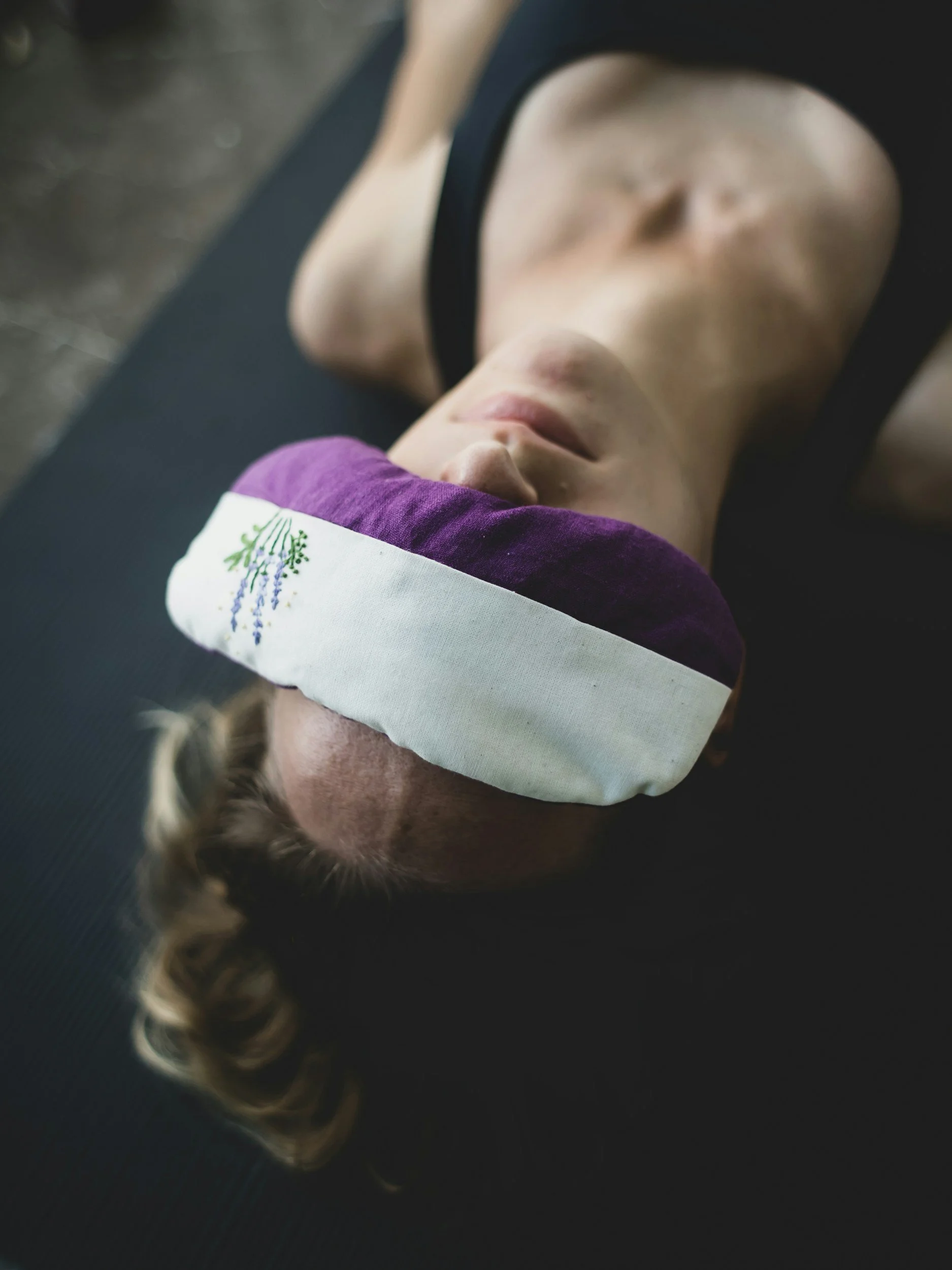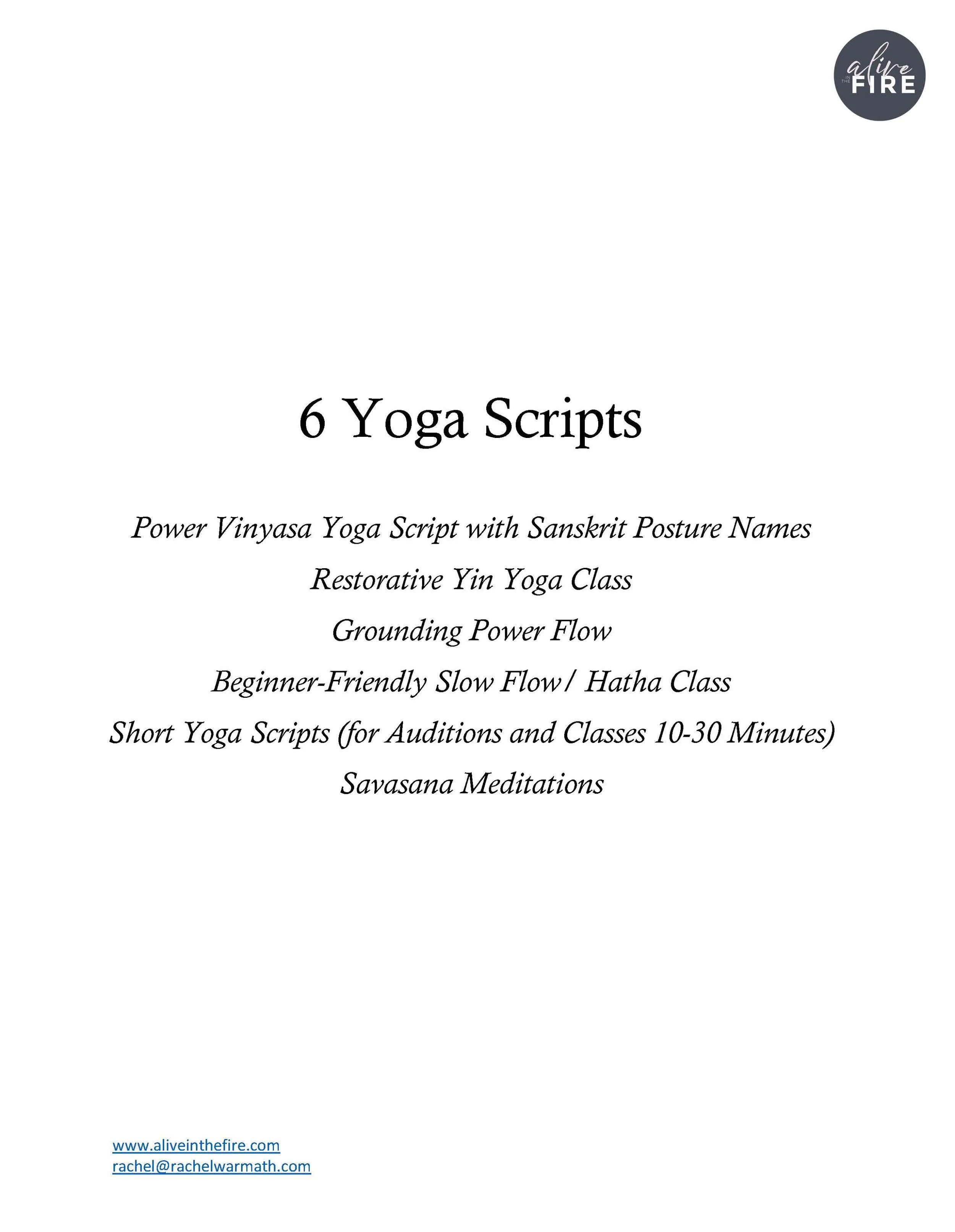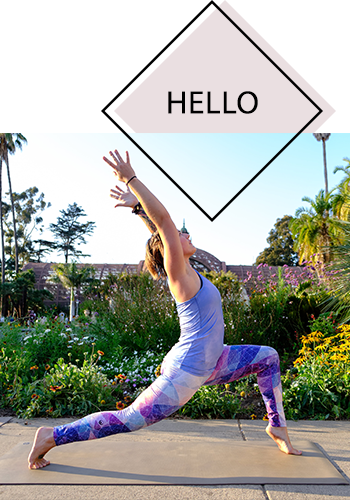How to Use a Yoga Nidra Script to Lead a Deep Relaxation Session
/How to Use a Yoga Nidra Script to Lead a Deep Relaxation Session
If you’re a yoga teacher, guiding a yoga nidra practice can feel both exciting and slightly intimidating—especially if it’s your first time. Having a clear and supportive yoga nidra script (or a few yoga scripts for relaxation) can take the guesswork out and help you feel more grounded and prepared to lead.
In this post, I’ll share why using a script for yoga nidra is helpful, how to structure your class, tips for guiding students into deep rest, and a sample closing yoga class script to use at the end of your session.
What Is Yoga Nidra?
Yoga nidra, often called “yogic sleep,” is a guided meditative state where the body is fully at rest, but the mind remains gently aware. It’s typically done lying down in savasana, and guided by a teacher using a yoga nidra script that moves students through layers of awareness—physical, mental, emotional, and energetic.
Unlike traditional seated meditation, where students must maintain a still and alert posture, yoga nidra allows for deep relaxation of the body while accessing a profoundly meditative state of consciousness.
The practice is rooted in ancient yogic teachings and was formalized more recently by Swami Satyananda Saraswati in the 20th century. Yoga nidra is sometimes referred to as a state between waking and sleeping—a liminal space where healing, release, and deep insight can occur.
Why Is Yoga Nidra Beneficial?
There’s a reason yoga nidra is becoming more popular, both in studio settings and as part of therapeutic practices: it works.
Here are some of the most powerful benefits of regular yoga nidra practice for students:
1. Deep Relaxation
Yoga nidra activates the parasympathetic nervous system, helping students drop into a true state of rest. In our high-stress, overstimulated world, this kind of nervous system reset is crucial.
2. Better Sleep
Many people who struggle with insomnia or restless nights find that yoga nidra helps them fall asleep more easily and stay asleep longer. Even a short 20-minute session can offer the restfulness of hours of sleep.
3. Reduced Anxiety and Stress
By guiding students to witness their thoughts and sensations without attachment, yoga nidra helps reduce mental chatter and soothe anxious thinking. It’s often used as part of trauma recovery and PTSD treatment for this reason.
4. Enhanced Creativity and Focus
Because yoga nidra brings the brain into alpha and theta states (associated with intuition, dreaming, and creative insight), it can be a powerful tool for artists, writers, and thinkers.
5. Accessible to All Bodies
Yoga nidra doesn’t require physical movement or flexibility. It’s suitable for every body, every ability level, and every age. That’s why it’s often used in hospital settings, mental health programs, and community wellness offerings.
Why Yoga Teachers Should Incorporate Yoga Nidra
Many yoga teachers are confident leading asana or vinyasa flow, but feel less certain when it comes to guiding stillness. That’s where a yoga nidra script or yoga scripts for relaxation become essential tools.
Here’s why offering yoga nidra can make you a more versatile, well-rounded teacher:
1. It Supports Your Students’ Nervous Systems
You may notice that your students arrive to class with visible signs of stress—tight shoulders, shallow breathing, a racing mind. Including yoga nidra helps them regulate their nervous systems and leave feeling grounded.
2. It Deepens Your Offerings
You can offer special classes or workshops focused entirely on yoga nidra, or pair it with restorative yoga, yin, or gentle flows. This gives you a broader range of yoga sequence ideas to work with and allows you to serve different audiences, from athletes to seniors to trauma survivors.
3. It Builds Trust in Your Teaching Voice
Learning to guide yoga nidra helps you develop a confident, calming tone and rhythm in your teaching. Over time, you’ll find your own voice and flow—even when working from a script.
4. It Encourages You to Slow Down, Too
As a teacher, you might be burning out from always leading fast-paced, physically demanding classes. Offering yoga nidra lets you teach from a more grounded, gentle place—and often, it supports your own nervous system as much as your students’.
Common Myths About Yoga Nidra
Many teachers and students shy away from yoga nidra because of a few lingering myths or misconceptions. Let’s clear some of those up:
Myth #1: Yoga Nidra Is Just Guided Meditation
While it has similarities to guided meditation, yoga nidra follows a specific structure—moving from physical awareness (body scan) to breath, to emotions, to visualization, and sometimes intention-setting (sankalpa). It’s more layered and intentional than simply “relax and follow my voice.”
Myth #2: You Have to Stay Awake the Whole Time
It’s totally OK if students fall asleep! In fact, it often means their bodies are deeply resting and receiving what they need. Over time, students may learn to hover in that liminal state between waking and sleep—which is where the true magic of yoga nidra happens.
Myth #3: Only Advanced Teachers Can Lead Yoga Nidra
Not true. If you’re a newer teacher, you can absolutely begin using a script for yoga nidra to guide students. As long as you practice delivering it with presence and care, you’re offering a beautiful, healing experience. With time, you’ll gain more confidence and may even begin writing your own yoga nidra scripts.
Why Use a Script for Yoga Nidra?
Yoga nidra—also known as “yogic sleep”—is a guided form of meditation that helps students shift into a deep state of rest and awareness. Using a script for yoga nidra ensures that you can guide your students through each essential stage of the practice, including body scanning, breath awareness, and visualization.
Even if you're an experienced yoga teacher, it can be helpful to have a written script, especially when guiding newer students or when you’re still building confidence in your teaching voice.
Many teachers also find that a closing yoga class script or a script for opening a yoga class helps provide structure and clarity at the beginning and end of class. It gives your teaching a consistent rhythm that students will appreciate.
How to Structure a Class with Yoga Nidra
Wondering how to build your class around yoga nidra? A yoga sequence builder tool or simple outline can help you organize your time. Here’s a basic format you can follow:
Sample Yoga Nidra Class Outline (60 minutes):
Opening (5 minutes): Set the tone using a script for opening a yoga class. Invite students to land, breathe, and begin turning inward.
Gentle Movement (10–15 minutes): Include floor-based postures or a slow flow. Think: supta baddha konasana, cat/cow, seated side stretch. These yoga sequence ideas promote relaxation and prep the body for stillness.
Pranayama or Breathwork (5 minutes): Guide a simple breath awareness or alternate nostril breathing.
Yoga Nidra (20–25 minutes): Use your yoga nidra script to guide students into deep rest.
Closing (5 minutes): Slowly bring students out, offer space to reflect, and end with gratitude using a closing yoga class script.
Tips for Using Yoga Scripts for Relaxation
Here are a few ways to make the most of your yoga nidra script and lead with confidence:
1. Practice Reading It OUT LOUD
Before you teach, practice your script out loud. Slow your pace, soften your tone, and allow pauses between phrases. Yoga nidra is about guiding students inward—less is more.
2. Use Sensory Language
Invite students to tune into their body, breath, and imagination. Phrases like “feel the weight of your body sinking into the mat” or “imagine a warm light moving through you” are powerful and calming.
3. Adapt the Script
Your yoga nidra script is a guide, not a rulebook. Adjust it depending on the time available, the energy of the group, or your own teaching style.
4. Build Familiarity
The more often you teach with scripts, the more you’ll naturally memorize parts of them and feel more fluid and intuitive in your delivery. Consider creating a personal library of yoga scripts for relaxation and yoga sequence ideas to pull from whenever needed.
Sample Yoga Nidra Script (Use for Closing Class)
You can use the following as a closing yoga class script, or as part of a full yoga nidra session.
[Yoga Nidra Script Begins]
“Find a comfortable position lying on your back. Allow your legs to relax, arms resting by your sides, palms up.
Gently close your eyes. Let your breath begin to slow down.
Bring your awareness to your body. Feel the points of contact between your body and the floor. Feel the support beneath you.
Now bring your attention to the crown of your head. Slowly scan your body downward, part by part.
Relax your forehead. Your eyes. Your jaw.
Soften your neck. Your shoulders.
Relax your arms, elbows, wrists, and fingers.
Bring awareness to your chest. Your belly. Soften and release.
Move your attention to your hips, thighs, knees, calves, ankles, and toes.
Feel your whole body resting. Completely supported.
Now, imagine a warm, golden light above you. See it begin to pour over you, moving slowly down your body—head, shoulders, arms, chest, legs. Let this light bring healing, calm, and peace.
Rest here. There’s nowhere to go. Nothing to do. Just be.
(pause for 3–5 minutes)
When you're ready, begin to bring awareness back to the body. Wiggle your fingers and toes. Stretch gently. Roll to one side.
In your own time, return to a seated position. Bring your hands to heart center.
Take one final breath together. Inhale… and exhale.
Thank you for taking this time for yourself. Namaste.”
[End Script]
Final Thoughts
Whether you’re brand new to teaching yoga nidra or simply want more confidence, a yoga nidra script is a great tool. When combined with a thoughtful yoga sequence builder, your yoga sequence ideas, and other class planning tools like a script for opening a yoga class, you’ll feel fully supported as a teacher.
And your students? They’ll leave class feeling grounded, calm, and renewed—because you created a space for them to truly rest.
Want More Ready-to-Use Yoga Scripts?
At Alive in the Fire, I offer downloadable yoga scripts for relaxation, including beginner-friendly yoga nidra scripts, savasana meditations, and scripts for opening and closing a yoga class. These are perfect for new teachers and seasoned instructors alike.
Here’s my most popular yoga nidra script, if you’re interested in checking it out!
Lead your students through a calming, relaxing Yoga Nidra practice using the Yoga Nidra script.
This 19-page PDF is a full guide that details exactly what to say, start to finish. Includes:
2 Yoga Nidra scripts (shorter and longer version)
Chakra Meditation script (moves through the 7 major energy centers in the body)
Information on how Yoga Nidra works and why it is effective
Detailed instructions for each stage of Yoga Nidra, including:
An initial period of relaxing and settling into a comfortable position
Focusing on the breath
Setting an intention (sankalpa)
Progressive relaxation throughout the body
Experience of opposite sensations such as hot and cold, heavy and light, etc.
Return to intention (sankalpa)
Chakra visualization and affirmations (root chakra, sacral chakra, navel chakra, heart chakra, throat chakra, third eye chakra and crown chakra)
The Yoga Nidra script is an effective way to guide your class through a powerful, calming, effective method for reducing stress.
Here’s what yoga teachers are saying about the YOGA NIDRA SCRIPT:
“I wasn’t sure how to teach Yoga Nidra and would sometimes get stuck in the middle of leading it. Now I have something I can read from and that I trust to guide my students into a state of deep relaxation.” -Sam, yoga teacher
”I’m constantly amazed by the results I see for my students when they do this practice. It’s highly effective and I will be teaching this for years! If you haven’t tried Yoga Nidra yet, please do— it will change your life!” -Silas, yin yoga teacher
About the CHAKRA MEDITATION:
“I really appreciated having this extra meditation from the script. I read it to my students during savasana and they get so much out of it. It’s great for clearing and balancing energy in a short period of time.” -Lisa, vinyasa yoga teacher


















Are you a new yoga teacher working to build your confidence? This 40-page e-book brings you practical, hands-on advice from over 25 experienced yoga teachers on how to kickstart your career, overcome imposter syndrome, receive feedback, and improve your skills. The book also includes 10 powerful meditations to help calm your nerves and ground your energy before class. Other topics include:
How to create kick-ass sequencing
How to get off your mat more while you teach
How to stop comparing yourself to other teachers
How to overcome burnout
How to create inspired social media content
How to decide if a class is worth starting or keeping
Are you ready to let go of imposter syndrome and find new levels of confidence as a yoga teacher? Begin here!